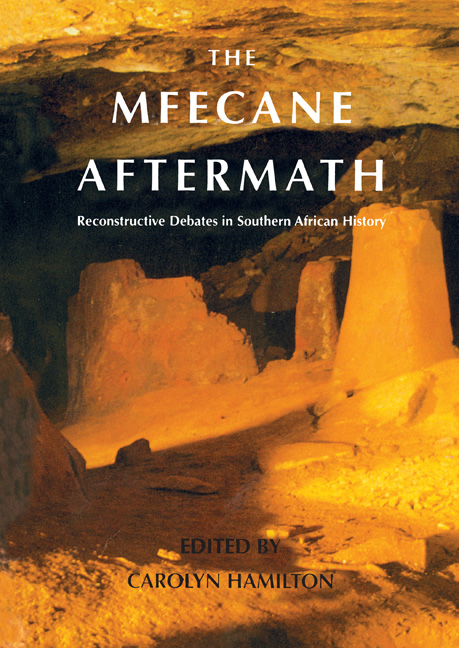Book contents
- Frontmatter
- Contents
- Maps
- Preface
- Acknowledgements
- Notes on Orthography and Names
- Contributors
- Introduction
- Part One Historiography and Methodology
- Part Two The South-Eastern Coastal Region
- Beyond the Concept of the ‘Zulu Explosion’ Comments on the Current Debate
- 5 Sources of Conflict in Southern Africa c. 1800-1830: The ‘Mfecane’ Reconsidered
- 6 Political Transformations in the Thukela-Mzimkhulu Region in the Late Eighteenth and Early Nineteenth Centuries
- 7 The Character and Objects of Chaka’: A Reconsideration of the Making of Shaka as Mfecane Motor
- 8 Matiwane's Road to Mbholompo: A Reprieve for the Mfecane?
- 9 Unmasking the Fingo: The War of 1835 Revisited
- 10 The Mfecane Survives its Critics
- Part Three The Interior
- Glossary
- Abbreviations
- Bibliographer's Note
- Bibliography
- Complete List of Papers Presented at the Colloquium
- Index
9 - Unmasking the Fingo: The War of 1835 Revisited
from Part Two - The South-Eastern Coastal Region
Published online by Cambridge University Press: 31 May 2019
- Frontmatter
- Contents
- Maps
- Preface
- Acknowledgements
- Notes on Orthography and Names
- Contributors
- Introduction
- Part One Historiography and Methodology
- Part Two The South-Eastern Coastal Region
- Beyond the Concept of the ‘Zulu Explosion’ Comments on the Current Debate
- 5 Sources of Conflict in Southern Africa c. 1800-1830: The ‘Mfecane’ Reconsidered
- 6 Political Transformations in the Thukela-Mzimkhulu Region in the Late Eighteenth and Early Nineteenth Centuries
- 7 The Character and Objects of Chaka’: A Reconsideration of the Making of Shaka as Mfecane Motor
- 8 Matiwane's Road to Mbholompo: A Reprieve for the Mfecane?
- 9 Unmasking the Fingo: The War of 1835 Revisited
- 10 The Mfecane Survives its Critics
- Part Three The Interior
- Glossary
- Abbreviations
- Bibliographer's Note
- Bibliography
- Complete List of Papers Presented at the Colloquium
- Index
Summary
‘Mfecane’ historiography has separated the advent of the Fingo from the war of 1835 (the so-called Sixth Frontier - or ‘Kafir’ - War). Its Afrocentric explanation of the arrival of the Fingo revolves around the claim that all Fingo were Natal refugees from the devastation of Shaka's ‘mfecane’, who fled south. They were rescued in May 1835 from the oppression of their Gcaleka hosts by the coincidental arrival of British troops in Butterworth. How the Europeans happened to be 300 kilometres from the colonial border is explained in white history as a defence of the Cape colony in the Sixth Frontier War. Both these compartmentalised histories - ‘mfecane’ and ‘settler’ - are based on myth. The identity of the Fingo in 1835 and the events of the war are intertwined: each is dependent upon a re-examination of the other.
The events of 1835 must be explained within the context of the early nineteenthcentury expansion of the Cape colony into Rharhabe territory - approximately the area bounded by the Fish and Kei Rivers, the Amatola Mountains and the Indian Ocean. The burgeoning European population demanded more land and labour, and the Rharhabe were increasingly pressurised into reacting to their inexorable dispossession. In late December 1834, after decades of trans-frontier raids by the colonists, the men of Maqoma, Tyali, Nqeno and Bhotumane attacked farmers in the Koonap River area, and the southern Albany region. The Albany settlers panicked, describing these retributive raids in dramatic hyperbole, and called for help from Cape Town. Governor Sir Benjamin D'Urban and Colonel Harry Smith then took the opportunity to subdue the ‘Kafir’ chiefs, seize most Rharhabe land, capture cattle and control the recalcitrant Gcaleka paramount, Hintsa. This was achieved by sending to the frontier a large force of British soldiers and colonists, who marched with relative impunity through Gcaleka and Rharhabe territory, plundering and burning as they went.
Along with the seizure of land and cattle came the capture of Rharhabe and Gcaleka (mainly women and children), who were taken back into the labour-starved eastern Cape to work on the settler farms. Such slavery was illegal so they were described as an oppressed people rescued by British humanitarianism and given the name ‘Fingo'. Included under the identity ‘Fingo’ was a range of other groupings which entered the colony during 1835.
- Type
- Chapter
- Information
- Mfecane AftermathReconstructive Debates in Southern African History, pp. 241 - 276Publisher: Wits University PressPrint publication year: 1995



